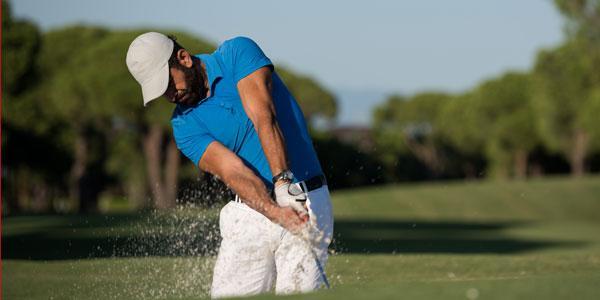Your Mindset and Playing With a Lead
Martin Kaymer went wire-to-wire to win the 2014 U.S. Open. Kaymer opened the tournament by shooting 65 on both Thursday and Friday’s rounds. His 10-under par score set the U.S. Open record for low scoring after 36 holes.
What was Kaymer’s mindset that helped him win the U.S. open wire-to-wire and perform well with a big lead?
When golfers are playing from behind, they have no option but to be aggressive. But when you open a big lead on the field after two rounds, it can play on your mind. You might say, “Do I play safe and protect the lead or try to be aggressive and keep going for birdies?”
According to Kaymer, you want to focus on the main objective: playing the golf course. “You always try to stay calm and focus on the main thing. And the main thing is really trying to challenge yourself and play your golf and play against the golf course and not too much against the other players,” Kaymer said after Sunday’s round.
Even the top golf pros feel pressure to finish off a tournament when they have a lead. Everyone remembers the player who blows the big lead in a major. Think Phil Michelson in last year’s U.S. Open. Greg Norman comes to mind also. Everyone knows who Van De Velde is.
“I would lie if I wouldn’t have felt pressure or if I wouldn’t have been nervous. Of course you’re nervous when you’re leading a Major championship. You can’t tell me that you are calm,” Kaymer said. “When you lead such a big tournament with five shots, it’s very, very difficult to keep going.”
Kaymer said the biggest challenge is to not think too far ahead about winning when you have a big lead. It’s hard to push out winning from your head when others are asking you about your big lead every day. “The challenge was not to think too much about that trophy, not to think too much about sitting in the media tent, about what you’re going to say.”
“It goes through your head, and I’m sure a lot of players feel the same way. Not many talk about it, but it is what it is. We do think about it. We are humans, and we’re not robots. A lot of emotions involved, a lot of expectations, and that’s what I said to Craig [Caddie].”
When you are playing with a big lead, it’s not easy. If you think you have a cushion, the lead can disappear quickly because golfers tend to protect the lead. Just because you have a five or six shot lead, doesn’t mean you want to play defensive.
What was Kaymer’s mindset for playing with a lead and closing it out?
“For me the challenge was to keep going, to stay aggressive, make birdies, go for some flags, and don’t hold back. And it’s very difficult to do, because at some stage you get a little bit tight and you want to — your body tells you, you should take it easy. I over came that feeling, I stayed aggressive, and I played very brave. So I’m very proud of that,” said Kaymer.
You can’t just say to yourself to play aggressive and don’t protect the lead. According to Kaymer, you have to believe it and then do it….
“If you want to keep going, how do you want to really do it from the inside, and that it comes — like it’s a true feeling. A lot of people can say ‘I want to keep going, I want to play aggressive.’ But then somehow you hold back. And how can I treat that feeling that is true?”
“You just have to do it. You have to convince yourself. You have to believe. You have to play brave,” said Kaymer.
Improve your mental toughness with one-on-one mental coaching with Dr. Cohn.
Related Sports Psychology Articles
- How to Finish The Tournament When Playing With a Lead
- Playing When In The Lead – Peaksports Video
- How to Perform Well When Leading the Match
*Subscribe to The Sports Psychology Podcast on iTunes
*Subscribe to The Sports Psychology Podcast on Spotify
Download a free sports psychology report to improve your mental game!
Learn more about our one-on-one mental game coaching.
Golfer’s Mental Edge

What’s the big sign that your mental game is the weak link in your golf game? When you can’t play consistently as well as when you play a practice or casual round–or your range game is way better than your game on the course. If you suffer from lack of focus, low self-confidence, poor composure or other mental game obstacles on the course, you can’t reach your true potential in golf.
The Golfer’s Mental Edge 2.0 Audio and Workbook program is ideal for any amateur, collegiate, junior, and tour professional golfer.
Golf coaches and instructors would also be wise to teach “The Golfer’s Mental Edge 2.0” principles to their players. This program is perfect for any golfer who wants to improve performance and consistency by managing their mind better on the course.

